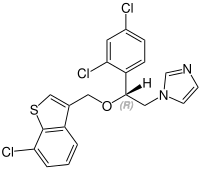Sertaconazole
| Structural formula | |||||||||||||
|---|---|---|---|---|---|---|---|---|---|---|---|---|---|

|
|||||||||||||
| Structural formula without stereochemistry | |||||||||||||
| General | |||||||||||||
| Non-proprietary name | Sertaconazole | ||||||||||||
| other names |
( RS ) -1- {2 - [(7-chloro-1-benzothiophen-3-yl) methoxy] -2- (2,4-dichlorophenyl) ethyl} -1 H -imidazole ( IUPAC ) |
||||||||||||
| Molecular formula |
|
||||||||||||
| External identifiers / databases | |||||||||||||
|
|||||||||||||
| Drug information | |||||||||||||
| ATC code | |||||||||||||
| Drug class | |||||||||||||
| Mechanism of action |
Inhibition of the biosynthesis of ergosterol in mushrooms |
||||||||||||
| properties | |||||||||||||
| Molar mass | |||||||||||||
| safety instructions | |||||||||||||
|
|||||||||||||
| Toxicological data | |||||||||||||
| As far as possible and customary, SI units are used. Unless otherwise noted, the data given apply to standard conditions . | |||||||||||||
Sertaconazole is a drug from the group of imidazole - antimycotics , which is used to treat superficial fungal infections of the skin. In addition to its broad spectrum of activity (against yeasts , dermatophytes , staphylococci , streptococci , Fusarium , Aspergillus ), sertaconazole is characterized by its high lipophilicity (Log P = 6.2) by a long persistence in the lipophilic areas of the skin ( stratum corneum and stratum lucidum ) out.
Effects
Sertaconazole has fungicidal , fungistatic , anti-inflammatory and anti-itch effects.
The main antifungal effect of sertaconazole is based on the inhibition of the enzyme lanosterol demethylase , which plays an important role in the synthesis of ergosterol , a component of the cell membranes of fungi.
The pruritus-relieving effect of sertaconazole is mediated by prostaglandin D2 and is comparable in its intensity and strength with the effect of hydrocortisone .
Therapeutic use
Sertaconazole is only slightly absorbed; after the dermal application of up to 16 g cream (320 mg active ingredient), no measurable plasma levels were found in test subjects (limit of quantification 25 ng / ml). In a study of the pharmacokinetics of sertaconazole, no active substance could be detected in blood or urine samples from test subjects after several days of external use. From this one can conclude that the active substance is practically not absorbed in humans. Sertaconazole is used pharmaceutically as a nitrate salt .
It is mainly used topically as a cream or spray (solution) to treat fungal infections of the skin caused by yeast or dermatophytes. Sertaconazole is both fungistatic and fungicidal in therapeutic doses against dermatophytes (the main pathogen causing athlete's foot ) . Very rare side effects of treatment with sertaconazole (i.e. less than 1 in 10,000 patients) are skin irritation such as redness, burning and itching.
Stereochemistry
Sertaconazole contains a stereocenter and consists of two enantiomers. This is a racemate , i.e. a 1: 1 mixture of ( R ) - and ( S ) -form:
| Sertaconazole enantiomers | |
|---|---|
 CAS number: 583057-48-1 |
 CAS number: 583057-51-6 |
Commercial preparations
- Mykosert (D), Zalaïn (D), Dermofix (ES), Ertaczo (USA)
Individual evidence
- ↑ a b Sertaconazole data sheet from Sigma-Aldrich , accessed on January 22, 2014 ( PDF ).
- ↑ a b Technical information Zalaïn ® , as of December 2011 (PDF; 36 kB)
- ↑ Entry on Sertaconazole in the DrugBank of the University of Alberta , accessed on November 7, 2016.
- ^ R. Susilo, HC Korting, UP Strauss, G. Menke, O. Schuster, A. Menke: Rate and extent of percutaneous absorption of sertaconazole nitrate after topical administration. In: drug research. Volume 55, number 6, 2005, pp. 338-342, doi : 10.1055 / s-0031-1296869 . PMID 16032974 .
- ↑ BM Ribotsky: Sertaconazole nitrate cream 2% for the treatment of tinea pedis. In: Cutis . Volume 83, Number 5, May 2009, pp. 274-277, PMID 19537285 .
- ↑ Simarna Kaur et al .: Induction of Prostaglandin D2 through the p38 MAPK Pathway Is Responsible for the Antipruritic Activity of Sertaconazole Nitrate . In: Journal of Investigative Dermatology (2010) 130, 2448-2456; doi : 10.1038 / jid.2010.152
- ^ F. Liebel, P. Lyte, M. Garay, J. Babad, MD Southall: Anti-inflammatory and anti-itch activity of sertaconazole nitrate. In: Archives of Dermatological Research . Volume 298, Number 4, September 2006, pp. 191-199, doi : 10.1007 / s00403-006-0679-8 , PMID 16868738 .
- ↑ M. Goldust, MR Ranjkesh, M. Amirinia, F. Golforoushan, E. Rezaee, MA Rezazadeh Saatlou: Sertaconazole 2% cream versus hydrocortisone 1% cream in the treatment of seborrheic dermatitis. In: Journal of Dermatological Treatment . February 2013, doi : 10.3109 / 09546634.2012.755251 , PMID 23210976 .
- ↑ N. Saki, F. Jowkar, S. Alyaseen: Comparison of sertaconazole 2% cream versus hydrocortisone 1% ointment in the treatment of atopic dermatitis. In: Journal of Dermatological Treatment. Volume 24, number 6, December 2013, pp. 447-449, doi : 10.3109 / 09546634.2013.782384 , PMID 23470235 .
- ↑ a b Technical information Mykosert ® Creme , as of November 2018 (PDF; 38 kB)
- ↑ Farré et al., Pharmacokinetics and tolerance of sertaconazole in man after repeated percutaneous administration , Drug Research . 1992; 42 (5A): 752-754
- ↑ Carrillo-Muñoz et al .: Sertaconazole Nitrate Shows Fungicidal and Fungistatic Activities against Trichophyton rubrum, Trichophyton mentagrophytes, and Epidermophyton floccosum, Causative Agents of Tinea Pedis , Antimicrob. Agents Chemother. September 2011 vol. 55 no. 9 4420-4421
- ↑ Rote Liste Service GmbH (Ed.): Rote Liste 2017 - drug directory for Germany (including EU approvals and certain medical devices) . Rote Liste Service GmbH, Frankfurt / Main, 2017, edition 57, ISBN 978-3-946057-10-9 , p. 217.